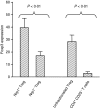Neuropilin-1 expression identifies a subset of regulatory T cells in human lymph nodes that is modulated by preoperative chemoradiation therapy in cervical cancer
- PMID: 18028372
- PMCID: PMC2433274
- DOI: 10.1111/j.1365-2567.2007.02737.x
Neuropilin-1 expression identifies a subset of regulatory T cells in human lymph nodes that is modulated by preoperative chemoradiation therapy in cervical cancer
Abstract
We examined the phenotype and function of CD4+ T cells expressing the semaphorin III receptor neuropilin-1 (Nrp1) in human lymph nodes and peripheral blood. In lymph nodes, Nrp1 identified a small regulatory CD4+ CD25(high) T-cell subpopulation (Nrp1+ Treg) that expressed higher levels of Forkhead box P3 (Foxp3) message and protein than Nrp1- Treg, and various molecular markers of activated Treg, i.e. CD45RO, human leucocyte antigen (HLA)-DR and glucocorticoid-induced tumour necrosis factor receptor (GITR). Similarly to conventional Treg, Nrp1+ Treg proliferated poorly in vitro, and exerted contact-dependent in vitro suppression of T-cell proliferation and cytokine secretion. However, Nrp1+ Treg were more efficient than Nrp1- Treg at inducing suppression. Nrp1 was also expressed on a small subpopulation of CD25(int) and CD25- CD4+ T cells that expressed more Foxp3, CD45RO, HLA-DR and GITR than their Nrp1- counterparts. In contrast, in peripheral blood Nrp1 identified a minor CD4+ T-cell subset that did not display the phenotypic features of Treg lacking Foxp3 expression and marginally expressing CD25. Hence, the function of Nrp1+ CD4+ T cells seemingly depends on their anatomical location. In a previous report, we proposed that Treg may curb the anti-tumour T-cell response in cervical cancer. We show here that Treg and Nrp1+ Treg levels dropped in the tumour-draining lymph nodes of patients with cervical cancer following preoperative chemoradiotherapy in a direct relationship with the reduction of tumour mass, suggesting that suppressor cell elimination facilitated the generation of T cells mediating the destruction of the neoplastic cells left behind after cytotoxic therapy.
Figures







References
-
- Zwar TD, Van Driel IR, Gleeson PA. Guarding the immune system: suppression of autoimmunity by CD4CD25 immunoregulatory T cells. Immunol Cell Biol. 2006;84:487–501. - PubMed
-
- Zou W. Regulatory T cells, tumour immunity and immunotherapy. Nat Rev Immunol. 2006;6:295–307. - PubMed
-
- Baecher-Allan C, Brown JA, Freeman GJ, Hafler DA. CD4+ CD25high regulatory cells in human peripheral blood. J Immunol. 2001;167:1245–53. - PubMed
-
- Baecher-Allan C, Wolf E, Hafler DA. MHC class II expression identifies functionally distinct human regulatory T cells. J Immunol. 2006;176:4622–31. - PubMed
MeSH terms
Substances
LinkOut - more resources
Full Text Sources
Other Literature Sources
Medical
Research Materials
Miscellaneous

